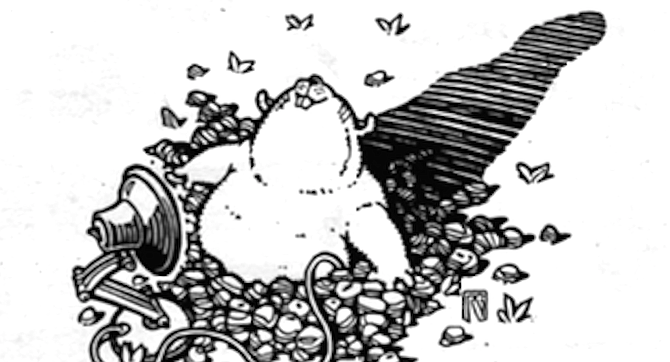 Facebook
Facebook
 X
X
 Instagram
Instagram
 TikTok
TikTok
 Youtube
Youtube

Matt: Where did Groundhog Day come from? Who decided that a groundhog could predict the weather? — “Rocky Squirrel,” San Diego
Our European ancestors gave us the idea for Punxsutawney Phil, that furry Farmers Almanac. February 2, Candlemas in the church calendar, was considered a good day for weather predictions, and animals were the best harbingers. The Germans sought out badgers or hedgehogs to help them calculate a date for spring planting. When they settled in the U.S., the so-called Pennsylvania Dutch (more'correctly, the Pennsylvania Deutsch) found no hedgehogs but were up to their hips in our equally mean-spirited groundhogs (more correctly, woodchucks; more informally, whistle pigs; scientifically, marmots).
Zoologically speaking, what’s going on in Punxsutawney every year is the eternal quest for (what else?) food and sex. The two urges and the warming weather break the animal’s hibernation. Punxsutawney Phil isn’t named Punxsutawney Phyllis because the males emerge first from their burrows. Waiting for the females to get up and make coffee, male groundhogs roam around for a few weeks, occupying themselves with the rodent equivalent of bar bets and fistfights. When you see Phil do his obligatory 15 seconds on TV tonight, remember, he’s rumored to be a reluctant conscript from a zoo, stuffed into the burrow before the cameras arrive. And thus far, he’s only been right 28 percent of the time.
The reason Punxsutawney Phil isn’t Palm Beach Phil is because Punxsutawney thought of it first. The stuff about groundhog shadows and six more weeks of winter is nonsense cooked up in 1886 as a town promotion scheme. The idea came from an earlier celebration, Punxsutawney’s annual, weeklong drinking party and woodchuck shoot. So there’s the truth about Groundhog Day, another illusion shattered.
But, hey, there’s always tomorrow: Setsubun, Japan’s annual bean-throwing festival. You get to drape your front door with garlands of sardine heads and hurl beans around your house and occasionally at other people. Has something to do with driving out the devil and welcoming spring. If you can wait until October, there’s another fine Japanese tradition, which involves walking through town swinging one of those big Oriental pickled radishes at the end of a rope. Personally, I’m partial to any celebration that involves blowing things up or throwing stuff. In parts of Mexico every year there’s the Fiesta de Agua, a town-wide, daylong, indoor-outdoor water fight, with no one sacred, no holds barred. And a friend once spent a hair-raising New Year’s Eve in Italy (Naples, I believe). At the stroke of midnight, town residents threw household goods from their balconies into the street — sofas, dishes, plumbing fixtures — whatever had worn out or broken down during the old year. Now that’s a party.


Matt: Where did Groundhog Day come from? Who decided that a groundhog could predict the weather? — “Rocky Squirrel,” San Diego
Our European ancestors gave us the idea for Punxsutawney Phil, that furry Farmers Almanac. February 2, Candlemas in the church calendar, was considered a good day for weather predictions, and animals were the best harbingers. The Germans sought out badgers or hedgehogs to help them calculate a date for spring planting. When they settled in the U.S., the so-called Pennsylvania Dutch (more'correctly, the Pennsylvania Deutsch) found no hedgehogs but were up to their hips in our equally mean-spirited groundhogs (more correctly, woodchucks; more informally, whistle pigs; scientifically, marmots).
Zoologically speaking, what’s going on in Punxsutawney every year is the eternal quest for (what else?) food and sex. The two urges and the warming weather break the animal’s hibernation. Punxsutawney Phil isn’t named Punxsutawney Phyllis because the males emerge first from their burrows. Waiting for the females to get up and make coffee, male groundhogs roam around for a few weeks, occupying themselves with the rodent equivalent of bar bets and fistfights. When you see Phil do his obligatory 15 seconds on TV tonight, remember, he’s rumored to be a reluctant conscript from a zoo, stuffed into the burrow before the cameras arrive. And thus far, he’s only been right 28 percent of the time.
The reason Punxsutawney Phil isn’t Palm Beach Phil is because Punxsutawney thought of it first. The stuff about groundhog shadows and six more weeks of winter is nonsense cooked up in 1886 as a town promotion scheme. The idea came from an earlier celebration, Punxsutawney’s annual, weeklong drinking party and woodchuck shoot. So there’s the truth about Groundhog Day, another illusion shattered.
But, hey, there’s always tomorrow: Setsubun, Japan’s annual bean-throwing festival. You get to drape your front door with garlands of sardine heads and hurl beans around your house and occasionally at other people. Has something to do with driving out the devil and welcoming spring. If you can wait until October, there’s another fine Japanese tradition, which involves walking through town swinging one of those big Oriental pickled radishes at the end of a rope. Personally, I’m partial to any celebration that involves blowing things up or throwing stuff. In parts of Mexico every year there’s the Fiesta de Agua, a town-wide, daylong, indoor-outdoor water fight, with no one sacred, no holds barred. And a friend once spent a hair-raising New Year’s Eve in Italy (Naples, I believe). At the stroke of midnight, town residents threw household goods from their balconies into the street — sofas, dishes, plumbing fixtures — whatever had worn out or broken down during the old year. Now that’s a party.
Comments